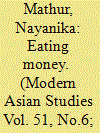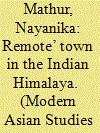|
|
|
Sort Order |
|
|
|
Items / Page
|
|
|
|
|
|
|
| Srl | Item |
| 1 |
ID:
158840


|
|
|
|
|
| Summary/Abstract |
This article studies corruption in India through an ethnographic elaboration of practices that are colloquially discussed as the ‘eating of money’ (paisa khana) in northern India. It examines both the discourse and practice of eating money in the specific context of the implementation of the National Rural Employment Guarantee Act, 2005 (NREGA). The article works through two central paradoxes that emerge in the study of corruption and the state. The first paradox relates to the corruption–transparency dyad. The ethnography presented shows clearly that the difficulties in the implementation of NREGA arose directly out of the transparency requirements of the statute, which were impeding the traditional eating of money. Instead of corruption being the villain it turns out that, in this particular context, it was its categorical Other—transparency—that was to blame. The second and related paradox emerges from an ethnographic examination of the processes and things through which development performance, corruption, and transparency are established and adjudged in the contemporary Indian state. Corrupt state practices and transparent state functioning are authoritatively proclaimed through an assessment of evidence—material proof in the form of paper—that is constructed by the Indian state itself. The push for transparency in India at the moment is not only leading to an excessive focus on the production of these paper truths but, more dangerously, is also deflecting attention away from what is described as the ‘real’ (asli) life of welfare programmes. Ultimately, this article contends that we need to eschew treating corruption as an explanatory trope for the failure of development in India. Instead of devising ever-more punitive auditing regimes to stem the leakages of the Indian state, this work suggests that we need a clearer understanding of what the state really is; how—and through which material substances—it functions and demonstrates evidence of its accomplishments.
|
|
|
|
|
|
|
|
|
|
|
|
|
|
|
|
| 2 |
ID:
164877


|
|
|
|
|
| Summary/Abstract |
In a political culture that experiences inordinately high levels of petitioning, what makes for a successful petition? This article studies petitions that have been efficacious in their appeals to capture or kill big cats in Himalayan India. The rates of success for any appeal against big cats are low in contemporary India, given the stringent legal regime that is geared almost exclusively towards the protection of the charismatic and endangered big cats as well as the hegemonic position occupied by wildlife conservationism. Furthermore, not only is it difficult to petition against cossetted big cats, but it is also not an easy task for any petition to be heard and acquiesced to. Through an ethnography of efficacious petitions, this article makes three related interventions. First, and in the process of attending to the rarity of a handful of efficacious petitions, this article argues for expanding our conceptualization of what, in practice, a petition is. It does so by outlining the changing forms of efficacious petitions, which can range from a telephone call, a register entry, a WhatsApp message from a smart phone, to the more ‘traditional’ paper-based petition. Beyond its ever-evolving medium, this article demonstrates the criticality of folding petitioning into a wider process that involves planning, performance, perseverance, repetition, and the capacity to elicit visceral responses. Finally, through an ethnographic foregrounding of human-big cat interactions, it demonstrates how an acceptance and elaboration of animal agency enriches the study of politico-legal processes.
|
|
|
|
|
|
|
|
|
|
|
|
|
|
|
|
| 3 |
ID:
139675


|
|
|
|
|
| Summary/Abstract |
This article studies the impact of the creation of a new state in northern India through an analysis of space. The space under consideration is the town of Gopeshwar, which serves as the administrative headquarters of a district in the state of Uttarakhand. Uttarakhand was created as a distinct Himalayan state in 2000 after a prolonged period of mass agitation to this end. The movement for statehood had emphasized historical neglect coupled with exploitation of
the mountains of Uttarakhand by the plains. Beginning with an analysis of the town plan, this article moves on to describe how this place is made into a space by everyday practices. In particular it concentrates on the narratives of agents of the state who express a longing to escape this ‘remote’ town. Through an interrogation of the trope of remoteness, this article argues that the creation of the new state has served, ironically enough, to accentuate the traditional characterization of the Himalaya as a backward, inferior space within India.
|
|
|
|
|
|
|
|
|
|
|
|
|
|
|
|
|
|
|
|
|